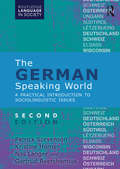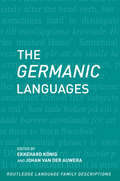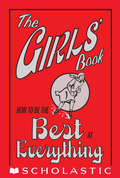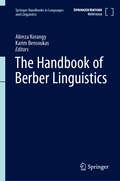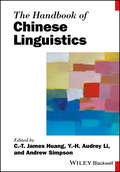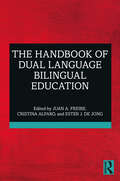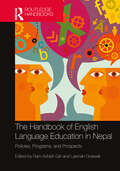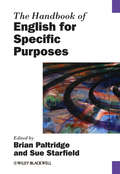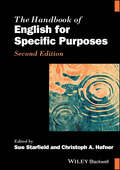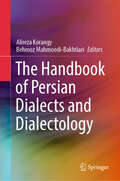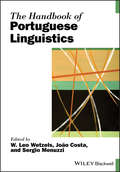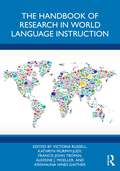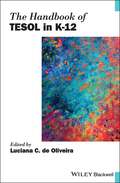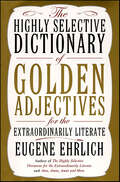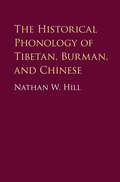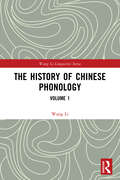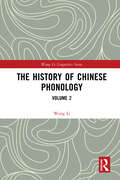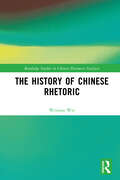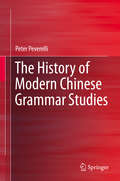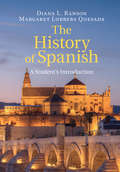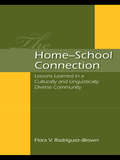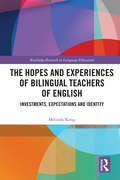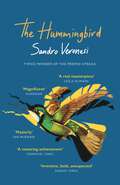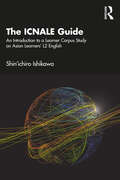- Table View
- List View
The German-Speaking World: A Practical Introduction to Sociolinguistic Issues (Routledge Language In Society Ser.)
by Patrick Stevenson Gertrud Reershemius Kristine Horner Nils LangerThe German-Speaking World is an accessible textbook that offers students the opportunity to explore for themselves a wide range of sociolinguistic issues relating to the German language and its role in the world. This new, second edition has been fully revised to reflect the many political and social changes of the last 20 years including the impact of technology on language change. It continues to combine text with practical exercises and discussion questions to stimulate readers to think for themselves and to tackle specific problems. Key features of this book: Informative and comprehensive: covers a wide range of current issues Practical: contains a variety of graded exercises and tasks plus an index of terms Topical and contemporary: deals with current situations and provides up-to-date illustrative material Thought-provoking: encourages students to reflect and research for themselves The German-Speaking World is the ideal textbook for undergraduate students who have a sound practical knowledge of German but who have little or no knowledge of linguistics or sociolinguistics.
The Germanic Languages (Routledge Language Family Series)
by Ekkehard Konig Johan van der AuweraProvides a unique, up-to-date survey of twelve Germanic languages from English and German to Faroese and Yiddish.
The Girls' Book: How to Be the Best at Everything (Best At Everything Ser.)
by Juliana Foster Amanda EnrightA spiffy guide to anything and everything a girl could need to know! How to do almost anything in one handy little book! Want to be known for your unique style? Inside you'll learn how to design your own clothes (p. 35), do the perfect manicure (p. 82), or make your own lip gloss (p. 11). Feel like impressing your friends? Show them how you can make a crystal (p. 16), juggle one-handed (p. 33), or deal with a bully (p. 42). Bored and need something to do? Not anymore when you find out how to keep a secret diary (p. 88), make a scrapbook (p. 9), or put together a dance routine (p. 24). And tons of other neat-o things you need to know how to do!
The Handbook of Berber Linguistics (Springer Handbooks in Languages and Linguistics)
by Alireza Korangy Karim BensoukasThis handbook is the largest and most comprehensive publication on Berber linguistics to date, covering the variety of Berber dialects and related linguistics trends. Extensive and diverse at thematic and theoretical levels, with the aim of deepening students and scholars' understanding of the workings of Berber as a linguistic phenomenon, it explores a multitude of angles through which the diachronic and synchronic intricacies of Berber varieties can be examined. It enables a better understanding of the issues in the various components of North African languages, as well as their theoretical and typological significance and implications. The work covers phonology and phonetics, morphology and syntax, semantics and pragmatics, socio-linguistics and dialectology, language teaching and psycholinguistics, lexicology, language contact and comparative linguistics, historical linguistics and etymology. Sub-themes explored include prosody, ideophones (and expressive language in general), morpho-syntactic categories, sociolinguistic variation and several other seminal interdisciplinary explorations. The chapters reflect the diversity of Berber varieties and include up-to-date scholarship by leading Berberists, with varieties including Figuig, Kabyle, Senhaja, Siwa, Standard Moroccan Amazigh, Tamazight, Tarifit, Tashlhit, Touareg, Tunisian Berber, Znaga, as well as Proto-Berber. A large geographical territory is covered, including Algeria, Egypt, Libya, Mali, Mauritania, Morocco, and Tunisia. With contributions from these Berber-speaking countries and their diaspora, there are also chapters from prominent Berber scholars from America, Australia and Europe. To this end, the volume includes perspectives and theories from different schools of linguistics. In including original French contributions and English translations of research from top scholars in the field, the book includes another vital dimension in terms ofthe resources, and sources. As a comprehensive reference, this work is of interest to North Africanists from various disciplines, including anthropologists, linguists, and sociologists, but particularly linguists interested in endangered languages, and those working on the historical and comparative study of the Afroasiatic language phylum.
The Handbook of Chinese Linguistics (Blackwell Handbooks in Linguistics)
by Andrew Simpson C.-T. James Huang Y.-H. Audrey LiThe Handbook of Chinese Linguistics is the first comprehensive introduction to Chinese linguistics from the perspective of modern theoretical and formal linguistics. Containing twenty-five chapters, the book offers a balanced, accessible and thoughtfully organized introduction to some of the most important results of research into Chinese linguistics carried out by theoretical linguists during the last thirty years. Presenting critical overviews of a wide range of major topics, it is the first to meet the great demand for an overview volume on core areas of Chinese linguistics.Authoritative contributions describe and assess the major achievements and controversies of research undertaken in each area, and provide bibliographies for further reading. The contributors refer both to their own work in relevant fields, and objectively present a range of competitor theories and analyses, resulting in a volume that is fully comprehensive in its coverage of theoretical research into Chinese linguistics in recent years. This unique Handbook is suitable both as a primary reader for structured, taught courses on Chinese linguistics at university level, and for individual study by graduates and other professional linguists.
The Handbook of Dual Language Bilingual Education
by Juan A. Freire Cristina Alfaro de Jong, Ester JThis handbook presents a state-of-the-art overview of dual language bilingual education (DLBE) research, programs, pedagogy, and practice. Organized around four sections—theoretical foundations; key issues and trends; school-based practices; and teacher and administrator preparation—the volume comprehensively addresses major and emerging topics in the field. With contributions from expert scholars, the handbook highlights programs that honor the assets of language-minoritized and marginalized students and provides empirically grounded guidance for asset-based instruction. Chapters cover historical and policy considerations, leadership, family relations, professional development, community partnerships, race, class, gender, and more. Synthesizing major issues, discussing central themes and advancing policy and practice, this handbook is a seminal volume and definitive reference text in bilingual/second language education.
The Handbook of English Language Education in Nepal: Policies, Programs, and Prospects
by Ram Ashish Giri and Laxman GnawaliThis book takes an interdisciplinary approach to explore wide-ranging topics from applied linguistics, education, sociology, political science, and cultural studies. It presents a comprehensive overview of English language education since its importation to Nepal.This volume covers English language education (ELE) politics and policy, theories and pedagogies, English as a medium of instruction, English teachers’ professional development, multilingualism and linguistic ecology, perspectives on equity, diversity and inclusion, as well as ELT and technology. Comprising scholarly discussions on emerging ELE issues in contemporary Nepal, the chapters explore various aspects of theoretical, and pedagogical considerations of ELE. While delving into the growing future of English in Nepal, it also presents analytical case studies of its controversial present and past practices. It sheds light on its development, shifting paradigms and present state of affairs, as well as the status of English in conjunction with the national language, Nepali and other Indigenous languages.This book will be useful to students, researchers and teachers of education, linguistics, and teacher training institutions. It will be an essential read for those involved in English language education, applied linguistics, EIL/WE/ELF, ESL/TESOL/ELT and TEFL, as well as for teachers, teacher educators, teacher trainees and international aid organisations.
The Handbook of English for Specific Purposes (Blackwell Handbooks in Linguistics #120)
by Brian Paltridge Sue StarfieldFeaturing a collection of newly commissioned essays, edited by two leading scholars, this Handbook surveys the key research findings in the field of English for Specific Purposes (ESP). • Provides a state-of-the-art overview of the origins and evolution, current research, and future directions in ESP • Features newly-commissioned contributions from a global team of leading scholars • Explores the history of ESP and current areas of research, including speaking, reading, writing, technology, and business, legal, and medical English • Considers perspectives on ESP research such as genre, intercultural rhetoric, multimodality, English as a lingua franca and ethnography
The Handbook of English for Specific Purposes (Blackwell Handbooks in Linguistics)
by Sue Starfield Christoph A. HafnerA field-defining survey of research in the rapidly growing field of English for Specific Purposes, now in its second edition The Handbook of English for Specific Purposes provides an up-to-date account of the origins, development, current state, and future directions in the study of English as used in its specific contexts, including medical English, business English, and academic English. Featuring research from leading authorities, this comprehensive volume addresses all key aspects of ESP, including speaking, reading, writing, legal English, nursing, assessment, intercultural rhetoric, multimodality, English as a lingua franca, and ethnography. The second edition of the Handbook is fully revised to incorporate new areas of ESP research and reflects changing demands on English Language Learners (ELL), including a new historical overview of the field by Prof. Vijay K. Bhatia and entirely new chapters English medium instruction and ESP research, materials development, teacher development, call center communication, Global Englishes and translanguaging, identity, and the emergence of digital genres. Unmatched in its breadth and depth of coverage, The Handbook of English for Specific Purposes: Features original state-of-the-art reviews relevant to scholars and students working across applied linguistics and education Features contributions by scholars working on ESP in a wide range of international contexts Addresses current and emerging challenges in ESP, with implications for related fields of TESOL and English language education more broadly Includes in-depth reviews of new ESP research findings and suggestions for further scholarship Part of the Wiley Blackwell Handbooks in Linguistics series, The Handbook of English for Specific Purposes, Second Edition, is an essential reference for upper-level undergraduate and graduate students, scholars, researchers, and educators working in TESOL, ELL/ELT, applied linguistics, and language studies.
The Handbook of Persian Dialects and Dialectology
by Alireza Korangy Behrooz Mahmoodi-BakhtiariThis innovative, investigative, and expansive handbook covers a multitude of angles through which the intricacies of Persian and its many dialects and accents can be examined and parsed with the view of understanding better the devices and paths through which language, and cultural cognizance, operate in tandem. As the first book in English to engage Persian dialects and dialectology on a broad and comprehensive scale, it develops an understanding of the paths through which maximization of the expressive power of words exists in Persian under the rubric of cultural conceptualizations. An insightful and all-encompassing resource for analyzing and augmenting knowledge of Persian linguistics, this work presents a thorough and all-encompassing interdisciplinary treatment of Persian. It is a vital resource for socio- and cultural linguists, as well as anthropologists and Iranists. It is also an excellent reference for historians researching Persian civilization, culture, literature and art.
The Handbook of Portuguese Linguistics
by W. Leo Wetzels Sergio Menuzzi João CostaThe Handbook of Portuguese Linguistics presents a comprehensive overview of research within the Brazilian and European variants of the Portuguese language. It includes chapters focusing on the key areas of linguistic study, including phonetics, phonology, morphology, syntax, semantics, pragmatics, linguistic change, language variation and contact, and acquisition. Essential reference work for scholars of Portuguese linguistics and Romance languages Chapters written by an international team of research specialists highlight both the consensus and the controversies within the various subfields of Portuguese linguistics Examines Portuguese linguistics in relation to syntax, phonology, morphology, semantics/pragmatics, acquisition, and sociolinguistics Written in an accessible overview style and designed for advanced students and current scholars in the field alike Essential reference work for scholars of Portuguese linguistics and Romance languages
The Handbook of Research in World Language Instruction
by Michael Byram Anthony J. Liddicoat Angela Scarino Michelle Kohler Erin Kearney Amy J. Heineke Maria M. Carreira Regine Hampel Terry A. Osborn Pablo Muirhead Paula Winke Victoria Russell Kathryn Murphy-Judy Theresa Catalano Francis John Troyan Joan Kang Shin Sébastien Dubreil James E. Coda Cécile Accilien Jason Martel Ursula Stickler Krishauna Hines-Gaither Manuela Wagner Myriam Abdel-Malek Emily Heidrich Uebel Felix A. Kronenberg Luca Giupponi Paula Garrett-Rucks Kristin J. Davin Victoria Russel Aleidine J. Moeller Violet Affleck Tasha Austin Beverly Baker Leslie Baldwin Katherine Barko-Alva Carl S. Blyth J. Dylan Burton Krista Chambless Celia Chomón Zamora Dorie Conlon Patricia W. Cummins Jason Fischbach Rebecca Kanak Fox Paul A. García Cassandra Glynn Deniz Gökçora Todd A. Hernández Susan A. Hildebrandt Bobby Hobgood Christina Huhn Knight, Stephanie W.P. Kris Aric Knisely Ali Kushki Brandon T. Locke Gillian Lord Inoussa Malgoubri Margaret E. Malone Kate McCrea Francis Paola Mendizábal Trina Philpot Montaño Meg Montee Raymond Oenbring Errol M. O’Neill Randolph Jr., L. J. Julio C. Rodriguez Lauren Rosen Bruna Sommer-Farias Danielle Steider Pete Swanson Julie M. Sykes Lynda Taylor Joshua J. Thoms Beth Wassell Kelley E. Webb Pamela M. Wesely Meredith McDonald White Jenniffer Whyte Kimberly M. Winslow Anna ZaitsevaThis seminal handbook provides a comprehensive overview of the research on world language education and how that research can transform into effective and daily instructional practices for K-16 language teachers.With contributions from leading scholars in the field, the volume addresses cutting-edge research, trends, and practice. Covering key topics in language education, the volume is organized in six sections: Teaching Methods and Approaches; Culture, Pragmatics, and Intercultural Communicative Competence; Assessment and Program Evaluation; Diversity, Equity, and Inclusion in the World Language Classroom; Technology Integration and Online Language Teaching and Learning; and Key Issues in World Language Instruction, including advocacy, teacher recruitment and retention, and professional development.This handbook is an essential text for all scholars, researchers, and educators in world languages.
The Handbook of TESOL in K-12 (Blackwell Handbooks in Linguistics)
by Luciana C. de OliveiraThe first handbook to explore the field of Teaching English to Speakers of Other Languages in elementary and secondary education (K-12) The number of students being educated in English has grown significantly in modern times — globalization, immigration, and evolving educational policies have prompted an increased need for English language learner (ELL) education. The Handbook of TESOL in K-12 combines contemporary research and current practices to provide a comprehensive overview of the origins, evolution, and future direction of Teaching English to Speakers of Other Languages at the elementary and secondary levels (K-12). Exploring the latest disciplinary and interdisciplinary issues in the field, this is a first-of-its-kind Handbook and contributions are offered from a team of internationally-renowned scholars. Comprehensive in scope, this essential Handbook covers topics ranging from bilingual language development and technology-enhanced language learning, to ESOL preparation methods for specialist and mainstream teachers and school administrators. Three sections organize the content to cover Key Issues in Teaching ESOL students in K-12, Pedagogical Issues and Practices in TESOL in K-12 Education, and School Personnel Preparation for TESOL in K-12. Satisfies a need for inclusive and in-depth research on TESOL in K-12 classrooms Presents a timely and interesting selection of topics that are highly relevant to working teachers and support staff Applies state-of-the-art research to real-world TESOL classroom settings Offers a balanced assessment of diverse theoretical foundations, concepts, and findings The Handbook of TESOL in K-12 is an indispensable resource for undergraduate and graduate students, researchers and scholars, and educators in the field of Teaching English to Speakers of Other Languages in elementary and secondary education.
The Highly Selective Dictionary of Golden Adjectives: For the Extraordinarily Literate (Highly Selective Reference)
by Eugene EhrlichAdjectives have long suffered from bad press. For many years, English teachers have been fond of telling students that "adjectives are the enemy of nouns, and adverbs are the enemy of everything else."While it's still advisable to heed your English teacher's advice on most other matters, The Highly Selective Dictionary of Golden Adjectives for the Extraordinarily Literate proves that breaking certain rules can make written and spoken language that much livelier, adding much-needed color, style, and adornment. With this addition to the popular Highly Selective series, the "golden" adjective, at last, gets the star treatment it deserves. From adventitious to zaftig, renowned lexicographer Eugene Ehrlich has collected more than 850 of the most interesting and engaging adjectives in the English language and has provided concise definitions and instructive usage examples. Whether you're a writer, a speaker, or a word buff, this compendious, trenchant, laudable, and all-around fantabulous volume will help you put panache back into your prose.
The Historical Phonology of Tibetan, Burmese, and Chinese
by Nathan HillThe discovery of sound laws by comparing attested languages is the method which has unlocked the history of European languages stretching back thousands of years before the appearance of written records, e.g. Latin p- corresponds to English f- (pes, foot; primus, first; plenus, full). Although Burmese, Chinese, and Tibetan have long been regarded as related, the systematic exploration of their shared history has never before been attempted. Tracing the history of these three languages using just such sound laws, this book sheds light on the prehistoric language from which they descend. Written for readers with little linguistic knowledge of these languages, but fully explicit and copiously indexed for the specialist, this work will serve as the bedrock for future progress in the study of these languages.
The History of Chinese Phonology: Volume 1 (Wang Li Linguistics Series)
by Wang LiAs the first volume of a two-volume set on the history of Chinese phonology, this book introduces the basics of the discipline and charts the history of phonology from the pre-Qin period to the Song dynasty.Based on abundant phonological materials, the author divides the history of Chinese phonology into nine historical periods, which helps illuminate its evolutions and principles. The first part of the book explains the fundamental concepts of the history and studies of Chinese phonology, including the rhyme dictionary, the rhyme table, dialect, and methodology, as well as fanqie, rhyme sets, division, and articulation. The second part discusses Chinese phonology across the first six periods, from the pre-Qin era (before 206 BCE) to the Song dynasty (960–1279), elucidating the phonological development and characteristics in terms of initials, rhyme groups, and tones.This title will be of great value for scholars and students studying Chinese phonology, Chinese linguistics, and readers interested in the essence of rhyming behind classic Chinese lyrics, poetry, drama, and other forms of verse.
The History of Chinese Phonology: Volume 2 (Wang Li Linguistics Series)
by Wang LiAs the second volume of a two-volume set on the history of Chinese phonology, this book studies the history of phonology from the Yuan dynasty until modern times and discusses the four approaches of sound change.Based on abundant phonological materials, the author divides the history of Chinese phonology into nine historical periods, which helps illuminate its evolutions and principles. Following on from the first volume, the first part of this second volume deals with the initials, rhymes, and tones of Chinese phonology from the Yuan dynasty (1279–1368) to modern times (since 1911), illustrating the diachronic sound changes with detailed tables. Based on an historical review of Chinese phonology, the second part of the book classifies sound changes via four major approaches: no change, gradual shift, split, and merger. It then analyzes the natural, conditional, and irregular sound changes, respectively, and the reasons for these changes.This title will be of great value for scholars and students studying Chinese phonology and Chinese linguistics, and readers interested in the essence of rhyming behind Chinese classic lyrics, poetry, drama, and other forms of verse.
The History of Chinese Rhetoric (Routledge Studies in Chinese Discourse Analysis)
by Weixiao WeiThis book challenges the existing misconception that there was no rhetoric in ancient China. Instead, this book provides ample evidence from public speeches in the Xia dynasty and oracle bone inscriptions in the Shang dynasty to public debates about government policies in the Han dynasty to show that persuasive discourse and rudimentary rhetorical techniques already existed in ancient China. Using literary analysis and discourse analysis methods, this book explains how the Mandate of Heaven was inscribed at the core of Chinese rhetoric and has guided Chinese thoughts and expressions for centuries. This book also demonstrates Chinese rhetorical wisdom by extracting many concepts and terms related to language expression, persuasive speech, morality and virtue, life and philosophy, and so on from great Chinese literary works. Well-known names, such as Confucius, Laozi, Sima Qian, Liu Xie, Mozi, Hanfeizi, Guibuzi and so on, are all touched upon with their famous theory and sayings related to and explicated from the rhetorical perspective. Many surprising facts are found by the author and revealed in the book. For example, a thousand years ago, the Chinese author Liu Xie already found that all words have preferred lexical neighbors and structural environment. This is later on ‘discovered’ by corpus linguistics and illustrated, for example, by the concepts of collocation and pattern grammar. This book targets postgraduate students, teachers, researchers and scholars interested in advanced Chinese language and Chinese literature, history, and culture.
The History of Modern Chinese Grammar Studies
by Peter PeverelliThis book discusses the way Chinese scholars developed a national grammar. Chinese didn't develop grammar until China's contact with Western grammar books in the 19th Century. The first indigenous grammar was published in 1889. It included some traditional notions, but mainly imitated European grammar. It was followed by a number of other similar works. To move away from this imitation, a group of grammarians started to look into the Chinese tradition of commenting on classics. This led to a variety of alternative grammars. After the war, Western linguistics started to gain influence in China. With the establishment of the PRC in 1949, efforts began to have a standard grammar adopted nationwide. The first attempt at such a grammar was published in 1956. This book spans the period 1898 - 1956. This book combines historiography and linguistics to distinguish different periods in the timespan covered. It shows how the development of a national grammar cannot be studied separately from language policies and discussions on the national language. The description of each period includes a general introduction of the relevant events in that period and a treatment of the major works of grammar.
The History of Spanish: A Student's Introduction
by Diana L. Ranson Margaret Lubbers QuesadaThis concise textbook provides students with an engaging and thorough overview of the history of Spanish and its development from Latin. Presupposing no prior knowledge of Latin or linguistics, students are provided with the background necessary to understand the history of Spanish. Short, easy-to-digest chapters feature numerous practice exercises and activities. Chapter 'Lead-in' questions draw comparisons between English and Spanish, enabling students to use their intuition about their native language to gain a deeper understanding of Spanish. Each chapter features further reading suggestions, an outline, and a summary. Highlighted key terms are collated in a glossary. Boxes on linguistic debates teach students to evaluate arguments and think critically about linguistics. Supporting online resources include Word files of all the practices and activities in the book and an instructor's manual featuring a sample syllabus, answer key to the practices and activities, sample exams and teaching suggestions. This book is ideal for a range of courses on the history of Spanish and Spanish linguistics.
The Home-School Connection: Lessons Learned in a Culturally and Linguistically Diverse Community
by Flora V. Rodriguez-Brown"In this unique contribution to the literature on parental involvement in culturally and linguistically diverse communities, Flora Rodríguez-Brown offers a critique of family literacy programs that lack a clear design for literacy activities relevant to community goals, offering an alternative model that is grounded within an abiding respect for the parents’ role as the child’s first, and ultimately, most important teacher." Robert D. Milk, University of Texas, San Antonio The Project FLAME program used as context for this book is a comprehensive family literacy model, supported by a strong sociocultural framework based on current research on cultural ways of learning and theories of multiliteracies and discourse. The model highlights the relevance of parents’ knowledge, cultural ways, and discourses in sharing literacy knowledge with their children. A pressing need exists for models and programs that effectively serve the educational needs of the steadily increasing numbers of culturally and linguistically diverse students in U.S. public schools today. Addressing issues related to development, implementation, and effectiveness of a program model that fulfills this need, this book is an essential resource for educators, community workers, and researchers interested in the relevance of the home-school connection in relation to children’s school success.
The Hopes and Experiences of Bilingual Teachers of English: Investments, Expectations and Identity (Routledge Research in Language Education)
by Melinda KongIn this age of internationalisation of higher education, many bilingual teachers from non-English-speaking contexts pursue their postgraduate degrees in English-speaking countries. Most programmes focus on providing content knowledge to them, while neglecting their investments. Furthermore, not much attention is given to what these bilingual teachers expect to gain from studying abroad, as well as their lived experiences and identity construction both inside and outside the classroom in English-speaking countries and when they return home. Nevertheless, these dimensions are crucial to their growth as teachers and users of English. This book explores these neglected aspects through case studies of bilinguals from various backgrounds. Through these case studies, the book examines the hopes, struggles and adaptation of bilinguals. It provides insights into what international students should realistically expect when studying overseas, and how to empower bilingual teachers, users and learners of English.
The Human Stain (Mandarin Edition)
by Philip RothIt is 1998, the year in which America is whipped into a frenzy of prurience by the impeachment of a president, and in a small New England town, an aging classics professor, Coleman Silk, is forced to retire when his colleagues decree that he is a racist. The charge is a lie, but the real truth about Silk would have astonished even his most virulent accuser."美国三部曲"的登峰之作 与前两部相比 小说中各元素之间更加制衡 更具整体性 对人性的探讨更加彻底 小说重磅炸弹似的主题 注定其成为各方评论的主题
The Hummingbird: ‘Magnificent’ (Guardian)
by Sandro VeronesiA BOOK OF THE YEAR FOR THE GUARDIAN: 'DEEPLY PLEASURABLE'A BOOK OF THE YEAR FOR THE SPECTATOR: 'WHAT A JOY''Magnificent' Guardian'A towering achivement' Financial Times'Inventive, bold, unexpected' Sunday Times'Everything that makes the novel worthwhile and engaging is here: warmth, wit, intelligence, love, death, high seriousness, low comedy, philosophy, subtle personal relationships and the complex interior life of human beings'Guardian'Not since William Boyd's Any Human Heart has a novel captured the feast and famine nature of a single life with such invention and tenderness'Financial Times'There is a pleasing sense of having grappled with the real stuff of life: loss, grief, love, desire, pain, uncertainty, confusion, joy, despair - all while having fun'The Sunday Times'Instantly immersive, playfully inventive, effortlessly wise'Observer'Masterly: a cabinet of curiosities and delights, packed with small wonders'Ian McEwan'A real masterpiece. A funny, touching, profound book that made me cry like a little girl on the last page'Leïla Slimani'A remarkable accomplishment, a true gift to the world'Michael Cunningham'Ardent, gripping, and inventive to the core'Jhumpa LahiriMarco Carrera is 'the hummingbird,' a man with the almost supernatural ability to stay still as the world around him continues to change.As he navigates the challenges of life - confronting the death of his sister and the absence of his brother; taking care of his parents as they approach the end of their lives; raising his granddaughter when her mother, Marco's own child, can no longer be there for her; coming to terms with his love for the enigmatic Luisa - Marco Carrera comes to represent the quiet heroism that pervades so much of our everyday existence.A thrilling novel about the need to look to the future with hope and live with intensity to the very end.THE NO. 1 INTERNATIONAL BESTSELLEROver 300,000 copies soldSoon to be a major motion pictureWinner of the Premio StregaWinner of the Prix du Livre EtrangerBook of the Year for the Corriere della Sera
The ICNALE Guide: An Introduction to a Learner Corpus Study on Asian Learners’ L2 English
by Shin'ichiro IshikawaThis book provides a practical and extensive guide for the International Corpus Network of Asian Learners of English (ICNALE), a unique dataset including more than 15,000 samples of Asian learners’ L2 English speeches and essays. It also offers approachable introductions to a variety of corpus studies on the aspects of Asian learners’ L2 English. Key topics discussed in the book include: background, aims, and methods of learner corpus research principles, designs, and applications of the ICNALE vocabulary, grammar, and pragmatics in Asian learners’ L2 English, and individual differences of Asian learners and assessments of their speeches and essays With many case studies and hands-on guides to utilise ICNALE data to the fullest extent, The ICNALE Guide is a unique resource for students, teachers, and researchers who are interested in a corpus-based analysis of L2 acquisition.
